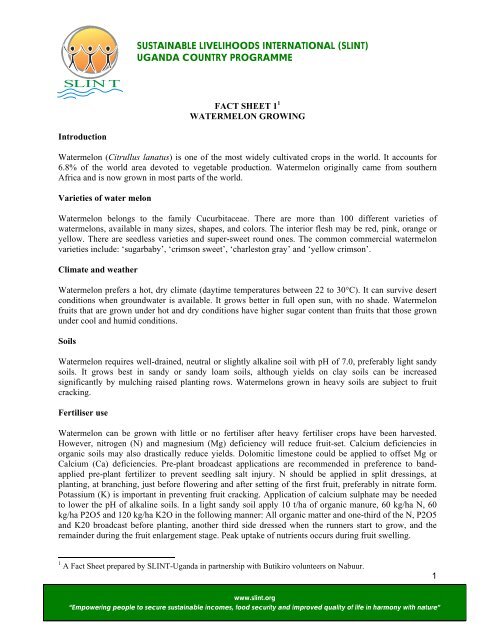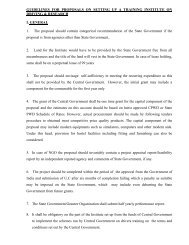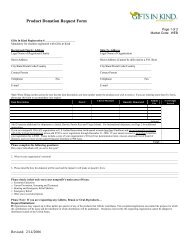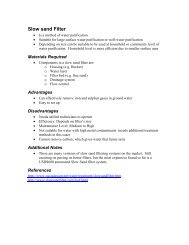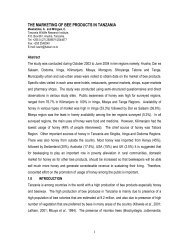FACT SHEET 1-Water Melon growing.pdf - Nabuur
FACT SHEET 1-Water Melon growing.pdf - Nabuur
FACT SHEET 1-Water Melon growing.pdf - Nabuur
You also want an ePaper? Increase the reach of your titles
YUMPU automatically turns print PDFs into web optimized ePapers that Google loves.
SUSTAINABLE LIVELIHOODS INTERNATIONAL (SLINT)<br />
UGANDA COUNTRY PROGRAMME<br />
SLIN T<br />
<strong>FACT</strong> <strong>SHEET</strong> 1 1<br />
WATERMELON GROWING<br />
Introduction<br />
<strong>Water</strong>melon (Citrullus lanatus) is one of the most widely cultivated crops in the world. It accounts for<br />
6.8% of the world area devoted to vegetable production. <strong>Water</strong>melon originally came from southern<br />
Africa and is now grown in most parts of the world.<br />
Varieties of water melon<br />
<strong>Water</strong>melon belongs to the family Cucurbitaceae. There are more than 100 different varieties of<br />
watermelons, available in many sizes, shapes, and colors. The interior flesh may be red, pink, orange or<br />
yellow. There are seedless varieties and super-sweet round ones. The common commercial watermelon<br />
varieties include: ‘sugarbaby’, ‘crimson sweet’, ‘charleston gray’ and ‘yellow crimson’.<br />
Climate and weather<br />
<strong>Water</strong>melon prefers a hot, dry climate (daytime temperatures between 22 to 30°C). It can survive desert<br />
conditions when groundwater is available. It grows better in full open sun, with no shade. <strong>Water</strong>melon<br />
fruits that are grown under hot and dry conditions have higher sugar content than fruits that those grown<br />
under cool and humid conditions.<br />
Soils<br />
<strong>Water</strong>melon requires well-drained, neutral or slightly alkaline soil with pH of 7.0, preferably light sandy<br />
soils. It grows best in sandy or sandy loam soils, although yields on clay soils can be increased<br />
significantly by mulching raised planting rows. <strong>Water</strong>melons grown in heavy soils are subject to fruit<br />
cracking.<br />
Fertiliser use<br />
<strong>Water</strong>melon can be grown with little or no fertiliser after heavy fertiliser crops have been harvested.<br />
However, nitrogen (N) and magnesium (Mg) deficiency will reduce fruit-set. Calcium deficiencies in<br />
organic soils may also drastically reduce yields. Dolomitic limestone could be applied to offset Mg or<br />
Calcium (Ca) deficiencies. Pre-plant broadcast applications are recommended in preference to bandapplied<br />
pre-plant fertilizer to prevent seedling salt injury. N should be applied in split dressings, at<br />
planting, at branching, just before flowering and after setting of the first fruit, preferably in nitrate form.<br />
Potassium (K) is important in preventing fruit cracking. Application of calcium sulphate may be needed<br />
to lower the pH of alkaline soils. In a light sandy soil apply 10 t/ha of organic manure, 60 kg/ha N, 60<br />
kg/ha P2O5 and 120 kg/ha K2O in the following manner: All organic matter and one-third of the N, P2O5<br />
and K20 broadcast before planting, another third side dressed when the runners start to grow, and the<br />
remainder during the fruit enlargement stage. Peak uptake of nutrients occurs during fruit swelling.<br />
1 A Fact Sheet prepared by SLINT-Uganda in partnership with Butikiro volunteers on <strong>Nabuur</strong>.<br />
1<br />
www.slint.org<br />
“Empowering people to secure sustainable incomes, food security and improved quality of life in harmony with nature”
Soil preparation and planting<br />
<strong>Water</strong>melons are deep-rooted, so before seeding, the soil should be deep-ploughed to at least one foot<br />
deep. <strong>Water</strong>melon is normally grown from seed by direct seeding in wet warm soil. The planting should<br />
be done immediately after the beginning of the first rains.<br />
Spacing and depth<br />
<strong>Water</strong>melon vines require considerable space. Plant seeds one inch (3-5cm) deep holes, spaced 6 feet (1.2<br />
to 2m) apart. Allow 7 to 10 feet (2 to 2.5m) between rows. After the seedlings are established, thin them<br />
and leave the best three plants per hole. Single transplants should be 2 to 3 feet apart and double<br />
transplants 4 to 5 feet apart in the rows.<br />
<strong>Water</strong>ing<br />
Always plant seeds into moist soil. Do not irrigate until after germination or the seeds will rot. The<br />
highest yields and quality are achieved by maintaining the plants free of water stress from establishment<br />
to final harvest.<br />
• Fully wet the soil profile in the plant row at or before planting.<br />
• After planting, allow roots to grow out into the moist soil profile, encouraging a large root system.<br />
During this time, water only when required to stop the plant going into water stress, and then water to<br />
fully rewet the soil profile.<br />
• Avoid frequent short watering.<br />
• After flowering, water when soil approach the refill point and water to field capacity until the end of<br />
harvest.<br />
Care<br />
<strong>Water</strong>melons should be kept free from weeds by shallow hoeing and cultivation. The plants have<br />
moderately deep roots and watering is seldom necessary unless the weather turns dry for a prolonged<br />
period.<br />
Extended periods of extremely dry weather when the melons were maturing can cause watermelons to<br />
rotting on the ends. This may be aggravated by continued deep hoeing or close cultivation. Mulching the<br />
plants helps to reduce this problem.<br />
Crop management to improve sugar content<br />
In order to enhance the sugar content of the water melon:<br />
• Plants should be maintained free of water stress from first flower until the end of harvest, including<br />
through the harvest period.<br />
• Root health is critical in producing fruit with high sugars. It is critical to start the crop cycle with a<br />
fully wetted soil profile, then water to field capacity when the soil moisture content falls to a<br />
predetermined refill point.<br />
• Fruit soluble solids can be improved by removing small fruit that will not be harvested about seven<br />
days before the start of harvest<br />
• Plants should be kept supplied with sufficient N, P, K and Ca in balanced applications so that plants<br />
don’t run out of nutrients before harvest.<br />
• Fruit load controls vegetative plant growth.<br />
• High N applications – more than 100 kg/ha N – do not reduce flowering or fruit set.<br />
• Growing locations which provide long sunny days with maximum temperature below 37oC and cool<br />
nights provide the best conditions for sugar accumulation in the fruit.<br />
2<br />
www.slint.org<br />
“Empowering people to secure sustainable incomes, food security and improved quality of life in harmony with nature”
• There is significant genetic potential to produce fruit with higher soluble solids than current standard<br />
varieties.<br />
Agronomic performance of various watermelon varieties<br />
Germination rates<br />
Commercial varieties have varying germination rates. ‘Crimson Sweet’ and ‘Charleston Gray’ germinate<br />
in the shortest time frame (6 and 7 days respectively) after sowing, (when soil temperature is in the<br />
optimum range of 21-30oC), while ‘Sugarbaby’ and ‘Yellow Crimson’ germinate after 9 and 11 days.<br />
Other varieties can take even a month.<br />
Flowering<br />
Flowering starts from the sixth week after planting and the first flower to open is always a male flower.<br />
Sugarbaby’ takes about 45 days to flower while ‘Crimson Sweet’, ‘Yellow Crimson’ and ‘Charleston<br />
Grey’ take 55, 58 and 59 days, respectively. The opening of the first female flower occurs about 6-13<br />
days after the opening of the first male flower. On average, watermelon flowers in about 80 days after<br />
planting. Sugarbaby’ takes the shortest time to open the first female flower (51 days), ‘Yellow Crimson’<br />
(66 days), Charleston Gray’ and ‘Crimson Sweet’ (68 days).<br />
Maturity period<br />
The maturity period is highly variable and can take up to 135 days. ‘Sugarbaby’ takes the shortest time to<br />
mature (101 days) followed by ‘Yellow Crimson’ (105 days), ‘Charleston Gray’ (111 days) and ‘Crimson<br />
Sweet’ (113 days). There is a strong correlation between the number of days to maturity and the number<br />
of days to the opening of the first female flower.<br />
Length of the main vine and number of branches<br />
The length of the main vine varies significantly among the different varieties: Crimson Sweet’ has the<br />
shortest main vine (201cm) and is also the least branched (5 branches), followed by ‘Sugarbaby’ (228cm<br />
with 7 branches), ‘Charleston Gray’ (233cm with 7 branches) and ‘Yellow Crimson’ (244cm with 9<br />
branches).<br />
Number of fruits and yield<br />
The number of fruits per plant also varies. ‘Yellow Crimson’ produces an average of 3.45 fruits/plant<br />
(1104 fruits/ha); ‘Sugarbaby’ 2.39 fruits/plant (765 fruits/ha) averaging 2.05 kg in weight while<br />
‘Charleston Gray’ produces an average of 1.5 fruits/plant (480 fruits/ha) averaging 1.77kg in weight.<br />
‘Crimson Sweet’ has the lowest yields of 0.89 fruits/plant (285 fruits/ha) weighing 1.44kg on average.<br />
There is a strong correlation between the number fruit number and the two yield components i.e. main<br />
vine length and branch number.<br />
Generally, ‘Yellow Crimson’ is one of the best commercial varieties with agronomic traits that lead to<br />
high yields. These include long main vine and extensive branching which are highly correlated to yields.<br />
Harvesting<br />
<strong>Water</strong>melons take between 100-135 days to mature, depending on the variety. It should be harvested by<br />
hand when the fruits have fully ripened. Many farmers experience difficulty in determining when<br />
3<br />
www.slint.org<br />
“Empowering people to secure sustainable incomes, food security and improved quality of life in harmony with nature”
watermelons are ripe. A combination of the following indicators could be used to determine if the<br />
watermelon is ripe for harvesting:<br />
• Light green, curly tendrils on the stem near the point of attachment of the melon usually turn brown<br />
and dry;<br />
• The surface color of the fruit turns dull;<br />
• The skin becomes resistant to penetration by the thumbnail and is rough to the touch; and<br />
• The bottom of the melon (where it lies on the soil) turns from light green to a yellowish color, i.e. as<br />
watermelon ripens, the ground spot changes from pale green or white to cream or yellow.<br />
The ripeness of a watermelon can also be determined by "thumping" the melon with a knuckle. The sound<br />
of a watermelon, when thumped with a finger, is a muffled, dull tone if it is ripe. An immature fruit will<br />
thump with a clear, metallic ringing tone. Many watermelons do not emit the proverbial "dull thud" when<br />
ripe. For these, the dull thud may indicate an over-ripe, mushy melon<br />
<strong>Water</strong>melons often weigh between three and 25kgs upon maturity.<br />
Insects and Diseases<br />
<strong>Water</strong>melons are susceptible to various pests and diseases that attack the roots, foliage, and fruit resulting<br />
in reduced yields. These include: Fusarium wilt, anthracnose, damping off, gummy stem blight, bacterial<br />
fruit blotch, yellow vine, bacterial rind necrosis, cercospora leaf spot, angular leaf spot, alternaria leaf<br />
spot, Phytophthora blight, powdery mildew, downey mildew and viral diseases. Some cultivars are<br />
resistant to some diseases.<br />
Powdery mildew is one of the severest watermelon diseases. It is caused by 2 fungal pathogens, Erysiphe<br />
cichoracearum and Sphaerotheca fulginea. These fungi occur mainly on leaves, which are most<br />
susceptible 2 to 3 weeks after unfolding. Powdery mildew appears as a dusty white or gray coating/<br />
fungal growth over both upper and lower leaf surfaces or other plant parts, and can be difficult to control.<br />
Exposed vines and fruit are more prone to sunscald, and the vines may shrivel. Powdery mildew also<br />
affects cucumber, squash, pumpkin and other varieties of the family Cucurbitaceae.<br />
Disease control is essential in order to have high-yields and high quality watermelons. For disease<br />
management:<br />
• Select a site with good air circulation and low humidity<br />
• Separate new plantings from old plantings<br />
• Use a crop rotation of at least one year<br />
• Control cucurbit weeds and other weeds.<br />
The most common pests are cucumber beetles. If they attack watermelon plants, apply a suggested<br />
insecticide for control. <strong>Water</strong>melon mosaic virus (WMV) and yellow mosaic virus (ZYMV) are other<br />
pests that infect cucurbits: melons, cucumbers, luffas, squash and pumpkins, and are usually transmitted<br />
by insects.<br />
Nutrition<br />
A traditional food plant in Africa, watermelon has potential to improve nutrition and boost food security.<br />
<strong>Water</strong>melon contains about six percent sugar by weight, the rest being mostly water (it is 92% water by<br />
weight). As with many other fruits, it is a source of vitamin C but is not a significant source of other<br />
vitamins and minerals unless one eats several kilograms per day. <strong>Water</strong>melons also contain a significant<br />
amount of amino acid citrulline.<br />
4<br />
www.slint.org<br />
“Empowering people to secure sustainable incomes, food security and improved quality of life in harmony with nature”


